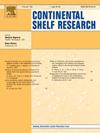Fatty acid profiling in the invasive brown seaweed Rugulopterix okamurae: A usefulness taxonomical tool
IF 2.2
3区 地球科学
Q2 OCEANOGRAPHY
引用次数: 0
Abstract
Rugulopterix okamurae is a macroalga native to the northwestern Pacific and recently found in Southeast (SE) Spain. This macroalga poses a serious threat because of its strong capacity to alter the community structure of marine ecosystems. This species is difficult to distinguish from native elements such as Dictyota spp.; thus, a simple tool for identifying these algae will be welcome. In this work, the fatty acid (FA) composition of R. okamurae and Dictyota spp. samples from several locations were determined and discussed from a chemotaxonomic point of view. In R. okamurae highlights palmitic, oleic, and arachidonic (ARA) acids, while in D. dichotoma eicosapentaenoic acid and ARA reached higher values than in R. okamurae. Further, Agglomerative Hierarchical Clustering analysis performed for selected FA ratios segregated R. okamurae from any Dictyota species, especially due to ARA + EPA proportions, thus FA profiling constitutes a valid chemotaxonomic tool for rapid identification of R. okamurae.

入侵褐藻的脂肪酸谱分析:一个有用的分类工具
okamurrugulopterix okamurae是一种原产于西北太平洋的大型藻类,最近在西班牙东南部被发现。这种大型藻类具有改变海洋生态系统群落结构的强大能力,对海洋生态系统构成严重威胁。这一种很难与本地元素如Dictyota spp区分;因此,一种识别这些藻类的简单工具将受到欢迎。本文从化学分类学的角度对不同产地的冈村野田鼠和野田鼠的脂肪酸组成进行了测定和讨论。okamurae中含有棕榈酸、油酸和花生四烯酸(ARA),而dichotoma中二十碳五烯酸和ARA含量高于okamurae。此外,对所选择的FA比例进行了聚类分析,特别是由于ARA + EPA的比例,因此FA谱分析是一种有效的快速鉴定okamurae的化学分类工具。
本文章由计算机程序翻译,如有差异,请以英文原文为准。
求助全文
约1分钟内获得全文
求助全文
来源期刊

Continental Shelf Research
地学-海洋学
CiteScore
4.30
自引率
4.30%
发文量
136
审稿时长
6.1 months
期刊介绍:
Continental Shelf Research publishes articles dealing with the biological, chemical, geological and physical oceanography of the shallow marine environment, from coastal and estuarine waters out to the shelf break. The continental shelf is a critical environment within the land-ocean continuum, and many processes, functions and problems in the continental shelf are driven by terrestrial inputs transported through the rivers and estuaries to the coastal and continental shelf areas. Manuscripts that deal with these topics must make a clear link to the continental shelf. Examples of research areas include:
Physical sedimentology and geomorphology
Geochemistry of the coastal ocean (inorganic and organic)
Marine environment and anthropogenic effects
Interaction of physical dynamics with natural and manmade shoreline features
Benthic, phytoplankton and zooplankton ecology
Coastal water and sediment quality, and ecosystem health
Benthic-pelagic coupling (physical and biogeochemical)
Interactions between physical dynamics (waves, currents, mixing, etc.) and biogeochemical cycles
Estuarine, coastal and shelf sea modelling and process studies.
 求助内容:
求助内容: 应助结果提醒方式:
应助结果提醒方式:


